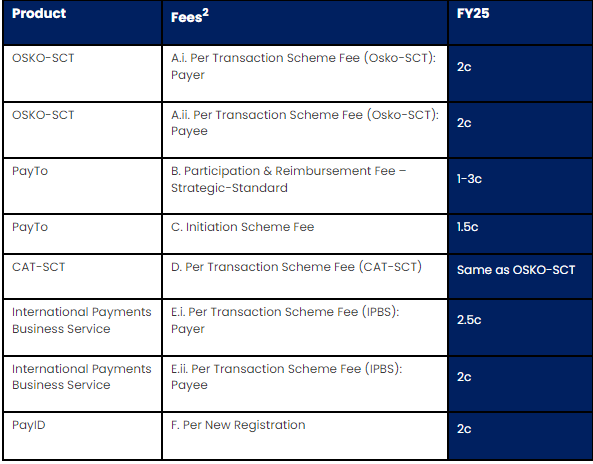Pricing objective
Our objective is to position NPP as a leading low-cost payment method across all relevant end-user segments. This includes enabling the migration of bulk payments and Direct Debits from Direct Entry, but also in the consumer to business retail payments space. The pricing model was developed to best meet the objectives of the AP+ Pricing Principles:
- AP+ seeks to be good for Australia and ‘good value’ for ecosystem participants
- AP+ intends its pricing strategy to support growth
- AP+ aims to deliver a fair return based on the AP+ product portfolio to underpin resilience and future growth
- Pricing should be commercially effective and simple where possible
- We seek to pursue a level playing field within commercial reality
FY24 pricing model
The current NPP wholesale pricing model is a tiered fixed contribution model. This was an interim model put in place while the NPP was in the early stages of volume growth.
NPP Australia signalled a shift to a per transaction pricing model when the network matured, and particularly given the launch of PayTo.
FY25 pricing model
A “per transaction’ pricing approach has been determined for FY25. These wholesale transaction fees will be charged by AP+ to NPP Participants and, where relevant, NPP Connected Institutions, (who will determine how they price services to their customers).
Transaction costs will continue to decrease as volumes increase
The theoretical price of an NPP transaction has continued to decrease every year as volume has grown [from ~14c in FY20 to ~6c in FY23]. Under the new model, we expect this dynamic to continue and the per transaction price to decrease further over time.
PayTo will be priced competitively with relevant substitutes
A Participation & Reimbursement Fee (PRF), paid from Payee Participant to Payer Participant, aims to position PayTo competitively, support participation of payer organisations, and reimburse them for wholesale network costs. The Participation and Reimbursement Fee (PRF) will be independently reviewed, at a minimum of every two years.
A small cost-recovery fee will be used for PayID as usage expands
We will apply a small one-off cost recovery fee for each PayID registration from FY25 to recover the costs of expanding and operating the PayID database in an equitable way.
An extensive consultation and approval process
AP+ began developing the FY25 NPP pricing principles and pricing model in October 2022, moving into an extensive consultation and feedback period with NPP Participants and the industry. A proposed pricing model was then shared for additional feedback before being submitted to the AP+ Independent Commercial and Compliance Committee (ICCC). The ICCC engaged an independent advisor who was involved throughout this review process.
The ICCC is made up of independent Directors on the AP+ Board who determine pricing for AP+ services (as well as other matters within its terms of reference).
FY25 Pricing

Notes:
- Incentives are provided to individual NPP Participants (including where clearing services are provided to a group, using a single Payments Access Gateway, by a single Participant) so they are encouraged to send more volume, through a series of six progressive volume tiers (from 0% to 20% progressive discount) calculated on payment scheme fee transactions (Osko-SCT, CAT-SCT, IPBS).
- On-us payment scheme fee transactions (Osko-SCT, CAT-SCT, IPBS) that utilise the PayID or PayTo database will be charged at a discounted (50%) rate.
- Direct Debits migrated to PayTo will be charged a discounted rate for FY25 and FY26. The discount, which applies to the Initiating/Payee Participant, reduces the Per Transaction Scheme Fee from 2c to 0c and the Initiation Scheme Fee from 1.5c to 0.5c.
- There will be a regular review of the pricing model. Fee levels or other pricing model adjustments will occur annually. The Participation and Reimbursement Fee (PRF) will be independently reviewed, at a minimum of every two years.
- FY25 pricing was updated from ‘guidance’ to ‘confirmed’ on 6-Mar-24
Contributions by “new joiners” to NPP initial build costs
“New joiner” contributions will continue to apply for Participants who want to directly connect to the NPP infrastructure. These new joiner costs, reducing each year until 2028, are directly referable to costs incurred by NPP Participants in building the NPP from 2013.
These costs entitle eligible organisations to physical equipment, a set of governance rights and obligations for NPP and access to NPP wholesale pricing for ongoing operational costs.
